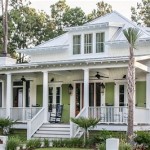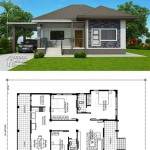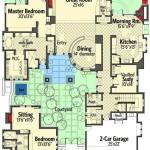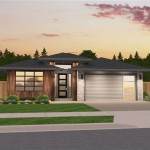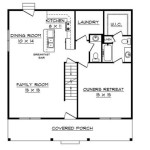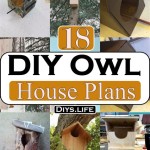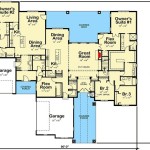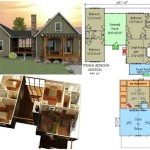Budget Friendly House Plans are architectural designs that prioritize cost-effectiveness while meeting the functional and aesthetic requirements of a habitable space. By incorporating clever design principles and utilizing cost-efficient materials and construction methods, these plans enable individuals and families to achieve their dream homes without breaking the bank. For instance, a well-executed budget-friendly house plan can result in a comfortable and stylish three-bedroom abode with an open-concept living area, ample natural light, and energy-saving features, all while staying within a modest budget.
Adopting a budget-conscious approach to homeownership offers numerous advantages. It allows individuals to maximize their financial resources, allocate funds for other essential expenses, and avoid excessive debt or financial strain. Moreover, it promotes responsible spending and encourages thoughtful decision-making throughout the design and construction process. In the following sections, we will delve into key considerations, design strategies, and practical tips for creating budget-friendly house plans that meet your specific needs and aspirations.
Budget-friendly house plans prioritize affordability while meeting essential needs. Consider these key considerations:
- Compact design
- Efficient layout
- Simple foundation
- Cost-effective materials
- Natural lighting
- Energy efficiency
- DIY potential
- Long-term savings
By incorporating these principles, you can create a comfortable and stylish home without breaking the bank.
Compact design
Compact design is a cornerstone of budget-friendly house plans, emphasizing efficient use of space to minimize construction costs and ongoing expenses.
- Reduced square footage: Smaller homes require less materials and labor to build, resulting in significant cost savings. By carefully considering your space requirements and eliminating unnecessary areas, you can achieve a comfortable and functional home without sacrificing livability.
- Optimized layout: A well-planned layout maximizes space utilization and minimizes wasted areas. Open-concept living areas, multi-purpose rooms, and built-in storage solutions create a sense of spaciousness while keeping the overall square footage manageable.
- Vertical space utilization: Compact designs often incorporate vertical elements to make the most of available space. Lofts, mezzanines, and high ceilings can provide additional living areas or storage without increasing the footprint of the home.
- Shared spaces: Combining functions and sharing spaces can further reduce the need for additional rooms. For example, a guest room can double as a home office, or a laundry room can be integrated into the kitchen or bathroom.
By embracing compact design principles, you can create a budget-friendly house plan that meets your essential needs without compromising on comfort or style.
Efficient layout
An efficient layout is crucial for budget-friendly house plans, as it minimizes wasted space and maximizes functionality, ultimately reducing construction and maintenance costs.
- Centralized living areas: Placing the kitchen, living room, and dining room in close proximity creates a sense of spaciousness and eliminates the need for separate hallways or foyers. This open-concept design promotes natural flow and interaction within the home while reducing the overall square footage required.
- Multi-purpose rooms: Designing rooms that can serve multiple functions allows for greater flexibility and space utilization. For example, a guest room can double as a home office, or a laundry room can be integrated into the kitchen or bathroom. This approach reduces the need for additional dedicated spaces, saving on construction costs and ongoing maintenance.
- Built-in storage: Incorporating built-in storage solutions, such as closets, shelves, and cabinetry, maximizes space utilization and eliminates the need for bulky furniture or separate storage units. These built-ins can be customized to fit specific needs and aesthetic preferences, providing ample storage without compromising on living space.
- Natural flow: A well-planned layout ensures a smooth and logical flow between different areas of the home. This reduces wasted steps and creates a more comfortable and efficient living environment. Careful consideration of traffic patterns, room placement, and door and window locations can optimize the functionality and usability of the space.
By implementing these efficient layout strategies, budget-friendly house plans can achieve maximum functionality and livability without increasing the overall size or construction costs.
Simple foundation
A simple foundation is a critical aspect of budget-friendly house plans, as it significantly impacts the overall construction costs and ongoing maintenance expenses.
- Slab-on-grade foundation: This type of foundation involves pouring concrete directly onto a prepared and leveled ground surface. It is a cost-effective option for stable soil conditions and areas with minimal risk of flooding or frost heaving. Slab-on-grade foundations eliminate the need for extensive excavation and complex footing systems, reducing labor and material costs.
- Crawl space foundation: A crawl space foundation raises the house slightly above the ground, creating a small, accessible space beneath the home. This design allows for easier access to plumbing, electrical, and HVAC systems for maintenance and repairs, reducing long-term costs associated with these systems. While slightly more expensive than a slab-on-grade foundation, a crawl space foundation can provide additional storage space and improve ventilation.
- Basement foundation: Although basements can provide additional living space and storage, they are generally more expensive to construct than slab-on-grade or crawl space foundations due to the excavation and waterproofing requirements. However, in areas with extreme weather conditions or a high water table, a basement foundation may be necessary to protect the home from moisture and flooding.
- Avoid complex foundation designs: Elaborate foundation designs, such as those with multiple levels or intricate shapes, can significantly increase construction costs. By opting for a simple and straightforward foundation design, you can save money while maintaining the structural integrity and functionality of your home.
Choosing a simple foundation that suits the specific soil conditions and building requirements can optimize construction costs and ensure the long-term durability of your budget-friendly house plan.
Cost-effective materials
Selecting cost-effective materials is essential for budget-friendly house plans. By carefully considering the materials used for the exterior, interior, and structural components, you can significantly reduce construction and maintenance costs without compromising on durability or aesthetics.
Exterior materials: Opt for materials that are affordable, durable, and require minimal maintenance. Vinyl siding, fiber cement siding, and metal roofing are excellent choices, as they are relatively inexpensive, weather-resistant, and can last for decades. Consider using natural materials such as stone or brick for accents or focal points, as they can add character and value to your home while staying within budget.
Interior materials: For interior walls and ceilings, drywall is a cost-effective and versatile option. It is easy to install, paint, and repair, allowing for flexibility in design and future renovations. Choose flooring materials such as laminate, vinyl, or tile that are durable, affordable, and easy to maintain. Avoid expensive hardwoods or natural stone flooring unless they are essential for your desired aesthetic.
Structural materials: While it is crucial to ensure the structural integrity of your home, you can still save money by choosing cost-effective materials. Consider using engineered lumber for framing, as it is stronger and more affordable than traditional lumber. Explore alternative roofing materials such as asphalt shingles or metal roofing, which are durable and budget-friendly options.
By carefully selecting cost-effective materials throughout your house plan, you can achieve significant savings while maintaining the quality, durability, and aesthetic appeal of your home.
Natural lighting
Incorporating natural lighting into your budget-friendly house plan can significantly reduce energy costs and create a more comfortable and inviting living environment. By maximizing the use of windows, skylights, and other natural light sources, you can illuminate your home with sunlight, reducing the need for artificial lighting during the day.
Windows: Place windows strategically to capture natural light from different angles throughout the day. Consider the orientation of your home to take advantage of sunlight patterns. Larger windows and sliding glass doors allow more light to enter, while well-placed windows can direct sunlight into specific areas of your home.
Skylights: Skylights are an excellent way to introduce natural light into interior spaces that may not have access to windows. They can be installed in hallways, bathrooms, closets, and even over staircases, providing additional illumination and reducing the need for artificial light.
Light-colored surfaces: Using light-colored paint, flooring, and countertops can help reflect and distribute natural light throughout your home. Avoid dark or heavy colors, as they can absorb light and make spaces feel smaller and darker.
By incorporating natural lighting into your budget-friendly house plan, you can create a brighter, more inviting, and energy-efficient home.
Energy efficiency
Incorporating energy-efficient features into your budget-friendly house plan can significantly reduce your monthly utility bills and create a more sustainable and comfortable living environment.
- Insulation: Proper insulation in the walls, attic, and foundation helps regulate indoor temperatures, reducing the need for heating and cooling. Consider using energy-efficient insulation materials such as fiberglass, cellulose, or spray foam to minimize heat loss and gain.
- Windows and doors: Energy-efficient windows and doors are designed to minimize heat transfer and air leakage. Look for windows with double or triple glazing, low-emissivity (low-e) coatings, and tight-fitting frames. Similarly, choose doors with weatherstripping and insulation to prevent drafts and heat loss.
- Appliances: Energy-efficient appliances, such as refrigerators, dishwashers, and washing machines, consume less energy to operate. Look for appliances with the Energy Star label, which indicates that they meet strict energy efficiency standards.
- Lighting: LED and CFL bulbs are highly energy-efficient and can significantly reduce lighting costs compared to traditional incandescent bulbs. Consider using natural lighting during the day and installing dimmer switches to control the intensity of artificial light.
By incorporating these energy-efficient features into your budget-friendly house plan, you can create a home that is not only cost-effective but also environmentally friendly.
DIY potential
Budget-friendly house plans often incorporate DIY (Do-It-Yourself) potential to further reduce construction costs and allow homeowners to customize their living spaces. By undertaking certain tasks themselves, homeowners can save on labor expenses and gain a sense of accomplishment while adding personal touches to their homes.
- Framing and assembly: With proper guidance and safety precautions, homeowners can assist with framing walls, installing roofing, and assembling prefabricated components. These tasks require basic carpentry skills and can save a significant amount on labor costs.
- Interior finishing: Homeowners can handle tasks such as painting, installing flooring, and assembling cabinetry. By taking on these finishing touches, they can personalize their home’s interior while reducing expenses.
- Landscaping: Landscaping can be a major expense, but homeowners can save money by performing tasks such as planting, mulching, and basic lawn care themselves. This allows them to create an outdoor space that suits their preferences without breaking the bank.
- Minor repairs and maintenance: With basic tools and knowledge, homeowners can handle minor repairs and maintenance tasks, such as fixing leaky faucets, replacing light fixtures, and cleaning gutters. By addressing these issues promptly, they can prevent costly problems down the road and extend the lifespan of their home.
Incorporating DIY potential into budget-friendly house plans empowers homeowners to actively participate in the creation of their dream homes while saving money and gaining valuable skills and satisfaction.
Long-term savings
Budget-friendly house plans prioritize long-term savings by incorporating sustainable design principles and durable materials. These homes are designed to minimize energy consumption, reduce maintenance costs, and increase the overall lifespan of the property, resulting in significant financial savings for homeowners over time.
Energy-efficient features, such as proper insulation, energy-efficient appliances, and natural lighting, can significantly reduce monthly utility bills. By minimizing heat loss and gain, homeowners can lower their energy consumption and save on heating and cooling costs. Energy-efficient appliances and lighting fixtures further contribute to long-term savings by consuming less energy compared to traditional options.
Durable materials and construction methods ensure the longevity of budget-friendly homes. By using high-quality materials, such as fiber cement siding, metal roofing, and engineered lumber, homeowners can reduce the likelihood of costly repairs and replacements in the future. Proper installation and regular maintenance further extend the lifespan of these materials, protecting the home from damage and deterioration.
Low-maintenance features, such as easy-to-clean surfaces, durable flooring, and low-maintenance landscaping, minimize the time and expense required for upkeep. Homeowners can save on cleaning supplies, repairs, and landscaping services, allowing them to channel their resources towards other important financial goals.
In summary, budget-friendly house plans provide long-term savings through energy efficiency, durable construction, and low-maintenance features. By investing in a well-designed and constructed home, homeowners can enjoy lower utility bills, reduced maintenance costs, and a property that retains its value over time.










Related Posts

